
Galium is a large genus of annual and perennial herbaceous plants in the family Rubiaceae, occurring in the temperate zones of both the Northern and Southern Hemispheres. Some species are informally known as bedstraw.

Psychotria is a genus of flowering plants in the family Rubiaceae. It contains 1,582 species and is therefore one of the largest genera of flowering plants. The genus has a pantropical distribution and members of the genus are small understorey trees in tropical forests. Some species are endangered or facing extinction due to deforestation, especially species of central Africa and the Pacific.

Luculia gratissima is a species of flowering plant in the family Rubiaceae. It is an ornamental plant that is found from the central Himalayas to northern Indo-China.

Luculia is a genus of flowering plants in the family Rubiaceae. It was described by Robert Sweet in 1826 and is currently found from the Himalayas to southern China. The species are shrubs or small trees, generally found on upland scrub and woodland or forest margins. They have large leaves from 20–35 cm with prominent veins carried in opposite pairs. The inflorescence is a terminal umbel or corymb of tubular/open ended white, pink or creamy flowers with 5 spreading petals. It may be from 10–20 cm, depending on the species.

Erithalis is a genus of flowering plants in the family Rubiaceae. The genus is found from southern Florida to tropical America.
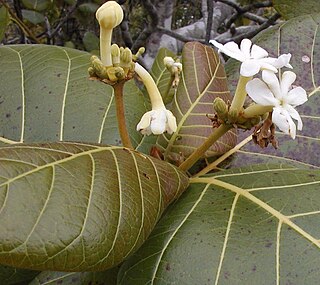
Guettarda is a plant genus in the family Rubiaceae. Most of these plants are known by the common name Velvetseed. Estimates of the number of species range from about 50 to 162. Most of the species are neotropical. Twenty are found in New Caledonia and one reaches Australia. A few others are found on islands and in coastal areas of the Indian and Pacific Oceans.
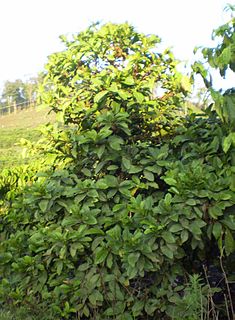
Coffea liberica is a species of flowering plant in the family Rubiaceae from which coffee is produced. It is native to western and central Africa from Liberia to Uganda and Angola, and has become naturalized in the Philippines, Indonesia, Seychelles, the Andaman & Nicobar Islands, Malaysia
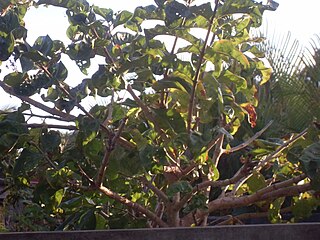
Vangueria madagascariensis, commonly known by the names Spanish-tamarind, tamarind-of-the-Indies, or voa vanga, is a species of flowering plant in the family Rubiaceae native to the African continent having edible fruit. It is the type species of the genus Vangueria and was described in 1791 by Johann Friedrich Gmelin.

Augusta is a genus of flowering plants in the family Rubiaceae. It is found in tropical Latin America from Mexico to Brazil and also in the southwestern Pacific.
Benzonia corymbosa is a species of flowering plants in the family Rubiaceae, endemic to Guinea in West Africa. It is the only species in the genus Benzonia. It was described by Heinrich Christian Friedrich Schumacher in 1827.
Temnopteryx is a monotypic genus of flowering plants in the family Rubiaceae. It was originally described by Joseph Dalton Hooker in 1873. It is found in Cameroon, Equatorial Guinee and Gabon.
Anthospermopsis is a monotypic genus of flowering plants in the family Rubiaceae. It was described by Joseph Harold Kirkbride Jr. in 1997. The genus contains only one species, viz. Anthospermopsis catechosperma, which is endemic to Bahia, Brazil.
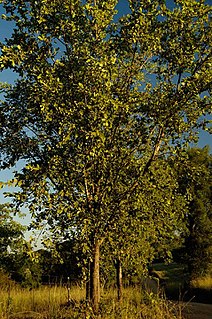
Crossopteryx is a monotypic genus of flowering plants in the family Rubiaceae. The genus contains only one species, viz. Crossopteryx febrifuga, which is found in tropical and southern Africa.
Deccania is a monotypic genus of flowering plants in the family Rubiaceae. The genus contains only one species, viz. Deccania pubescens, which is endemic to India.
Diyaminauclea is a monotypic genus of flowering plants in the family Rubiaceae. The genus contains only one species, viz. Diyaminauclea zeylanica, which is endemic to Sri Lanka.
Dunnia is a monotypic genus of flowering plants in the family Rubiaceae. The genus contains only one species, viz. Dunnia sinensis, which is endemic to Guangdong.
Durringtonia is a monotypic genus of flowering plants in the family Rubiaceae. The genus contains only one species, viz. Durringtonia paludosa, which is endemic to Australia.
Eleuthranthes is a monotypic genus of flowering plants in the family Rubiaceae. The genus contains only one species, viz. Eleuthranthes liberiflora, which is endemic to Western Australia.
Trailliaedoxa is a monotypic genus of flowering plants in the family Rubiaceae. The genus contains only one species, viz. Trailliaedoxa gracilis, which is endemic to south-central China. It is also the only species in the tribe Trailliaedoxeae.
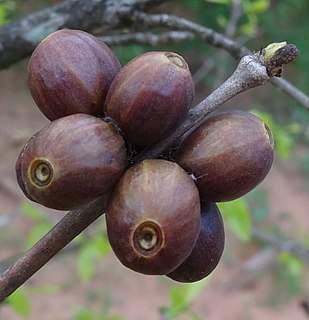
Coffea racemosa, or racemosa coffee, is a species of flowering plant in the family Rubiaceae. It has naturally low levels of caffeine, less than half of that found in Coffea arabica, and a quarter of that in Robusta coffee. It is endemic to the coastal forest belt between northern KwaZulu-Natal in South Africa and Zimbabwe, found in an area less than 150 km2 (58 sq mi) in size. It was widely cultivated by the Portuguese during the 1960-1970s in Mozambique, currently there are only two plantations at Ibo Island and in Hluhluwe, which remain.









